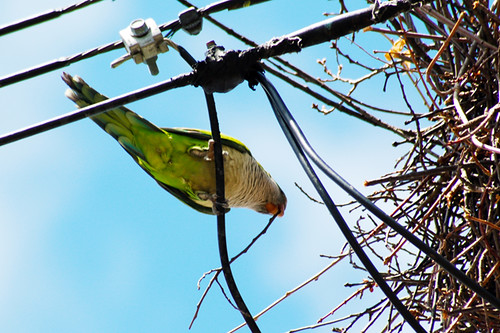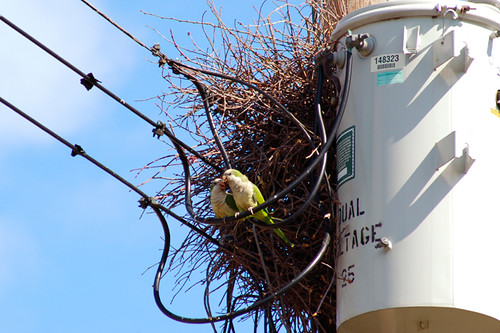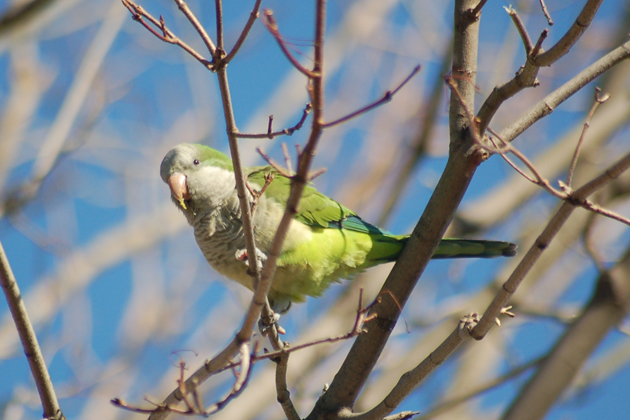Beating Monk Parakeets at Their Own Game
 Tuesday, September 30, 2014 at 13:19
Tuesday, September 30, 2014 at 13:19  A Monk Parakeet with a twig in its beak perches on an electric line at a nesting site in Stratford, Conn. Image by Kevin BurgioUniversity of Connecticut researchers have discovered that preventing Monk Parakeets, an invasive species of parrot, from building huge nests on utility poles by blocking their access to the electric lines can reduce the risk of power outages and costly damages.
A Monk Parakeet with a twig in its beak perches on an electric line at a nesting site in Stratford, Conn. Image by Kevin BurgioUniversity of Connecticut researchers have discovered that preventing Monk Parakeets, an invasive species of parrot, from building huge nests on utility poles by blocking their access to the electric lines can reduce the risk of power outages and costly damages.
“Block their route along the lines, and you’ll keep the birds from building nests in the first place,” says lead author Kevin Burgio, a UConn Ph.D. student in ecology and evolutionary biology, in a study published this week in the online journal PeerJ.
The nests, built out of sticks and twigs, can weigh up to 200 pounds or more, and the damage they cause can cost electric utility companies millions of dollars annually.
 A pair of Monk Parakeets sitting on a powerline just outside their nest in Stratford, Conn. The nests can weigh up to 200 pounds or more. Image by Kevin BurgioThe Monk Parakeets (Myiopsitta monarchus), native to subtropical South America, were introduced to the United States in the pet trade in the early 1960s. Some escaped or were released, and established breeding populations in Florida, Connecticut, New York, Illinois, and elsewhere.
A pair of Monk Parakeets sitting on a powerline just outside their nest in Stratford, Conn. The nests can weigh up to 200 pounds or more. Image by Kevin BurgioThe Monk Parakeets (Myiopsitta monarchus), native to subtropical South America, were introduced to the United States in the pet trade in the early 1960s. Some escaped or were released, and established breeding populations in Florida, Connecticut, New York, Illinois, and elsewhere.
Bright green and noisy, the birds attract the ire of homeowners by cutting sticks out of live trees and using them to build large, communal nests, often on utility poles. When the nests get big enough to bridge the gap between live electrical lines, they short the lines out, sometimes blowing transformers and turning off the power in whole neighborhoods.
Burgio and his co-authors studied the birds in order to find out if there was a way to block nest building on utility poles before it got started. They watched birds from the beginning of the nest-building process, and discovered that the parakeets carry sticks to the nest site by landing on the lines and walking to the spot where the line meets the pole, instead of flying there directly.
“They can’t land on the pole itself,” Burgio says, “because they need their beaks to climb up or down to where the line attaches to the pole, and they’re using their beaks to hold the sticks. So when they’re starting to nest, they land on the line and walk to the pole instead.”
Co-author Margaret Rubega, associate professor of ecology and evolutionary biology, says the birds “look like a guy walking a gangplank with a stick in his mouth.” Rubega is Connecticut’s State Ornithologist and is also Burgio’s Ph.D. advisor.
 A Monk Parakeet perched in a tree in West Haven, Conn. Image by Kevin BurgioEven when the nest is big enough to land on, the birds still use the line as a walkway most of the time. Burgio’s study also showed that the parakeets drop the sticks often early in the nest building process and, if dropped, they are not picked up again. Instead, the birds fly off and pick up a fresh branch and just start over.
A Monk Parakeet perched in a tree in West Haven, Conn. Image by Kevin BurgioEven when the nest is big enough to land on, the birds still use the line as a walkway most of the time. Burgio’s study also showed that the parakeets drop the sticks often early in the nest building process and, if dropped, they are not picked up again. Instead, the birds fly off and pick up a fresh branch and just start over.
The report says Monk Parakeet nests in Florida caused 198 power outages in one five-month period, leaving 10,000 people without power. Attempts to discourage the birds with owl decoys on utility poles have failed; when their nests are removed, they return quickly and build again. Killing the birds is unpopular, and repeated nest removals are costly for utility companies. In Florida, alone, utilities removed 3,000 nests in a five-year period, and spent an estimated $4.7 million.
“Knowing what we know now, we’re confident that a device for keeping the birds from walking over the last foot or so of line to the pole will keep them from being able to start a nest on a utility pole,” Burgio says.
Such a solution would make it possible for utility companies to keep the lights on in neighborhoods where the parrots live, without the cost of repeated nest removals and the damage that results when nests catch fire.
Burgio and Rubega are working with Midsun Group Inc., a manufacturer of utility equipment, to develop a device that uses the results of the study to exclude Monk Parakeets from utility poles.
Burgio, who graduated from UConn in 2010, began studying Monk Parakeets as an undergraduate, with Rubega as his advisor.
 Myiopsitta monachus - Monk Parakeet | in
Myiopsitta monachus - Monk Parakeet | in  Urban parrots
Urban parrots 
